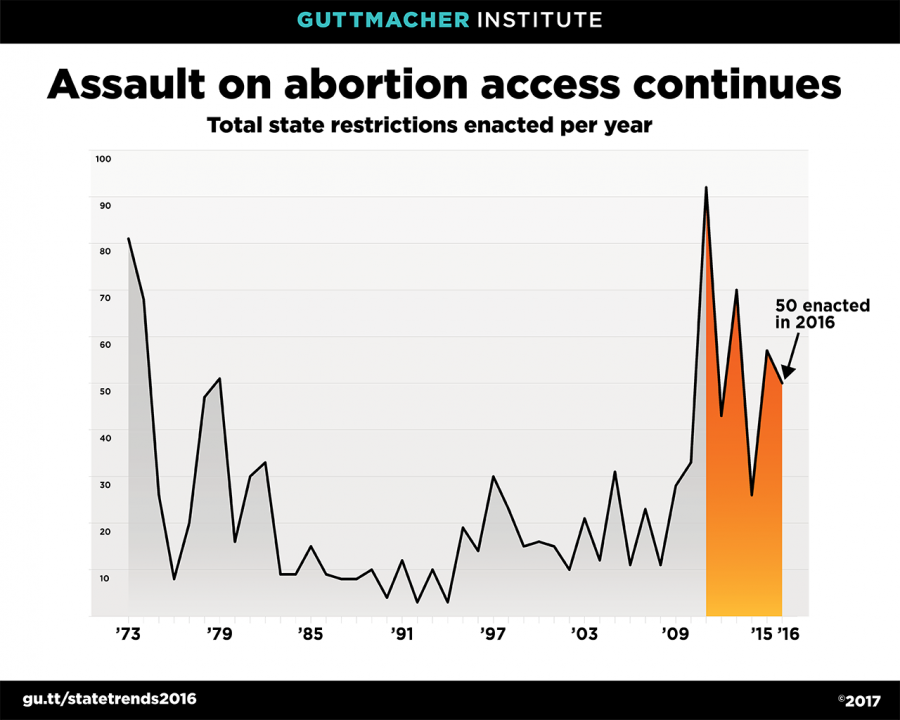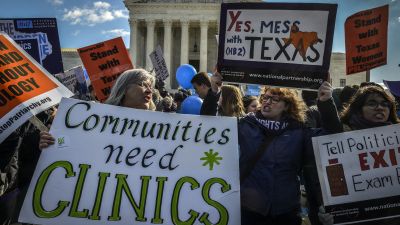In some states a few inches can be the stumbling block that forces an abortion provider to shut down: the width of the clinic’s hallway, the size of its examination, procedure and recovery rooms, the dimension of the janitor’s closet, or the minimum distance to the nearest hospital are all abortion-clinic specifications that can prevent providers from getting a state license. These regulations are known as TRAP laws — Targeted Regulation of Abortion Providers. Proponents say they’re meant to protect women’s health, but most of these rules are medically unnecessary to secure a procedure that is already extremely safe. Many TRAP laws result in the closure of abortion clinics due to excessive, expensive and unnecessary rules.
Types of TRAP Laws
While there are different types of TRAP laws, the common strategy is to hold clinics to unnecessary and often costly standards.
- Abortion providers are made to fulfill standards, personnel qualifications, building and or structural requirements that are usually mandatory for ambulatory surgical center (ASC) certification. These specifications are not necessary for nonsurgical abortions.
- Clinic doctors are required to obtain admitting privileges at local hospitals. This is difficult if a local hospital opposes abortion, or if a physician is required to admit a minimum number of patients a year. Since few abortion patients require hospitalization, it is usually impossible for a clinic physician to meet the minimum number of admissions.
- Location requirements that compel abortion providers to be geographically close to a hospital or a certain distance away from schools.
- Reporting requirements that force abortion providers to hand over private medical information and abortion data to the state government.
The American Medical Association, the American College of Obstetricians and Gynecologists and others concur that abortion is “one of the safest medical procedures performed in the United States.” Forcing clinics to close, on the other hand, puts abortion out of reach for women who live far from the remaining clinics. Rural and low-income women are often those most affected due to the costs associated with traveling and time away from home.
Texas Game-Changer
One of the most restrictive TRAP laws in the country was overturned by the US Supreme Court in 2016. The 5-3 decision in Whole Woman’s Health v. Hellerstedt found Texas’ House Bill 2 to be unconstitutional, unduly requiring abortion providers to have admitting privileges at a nearby hospital and requiring clinics to have facilities comparable to an ambulatory surgical center.
The court found that the law had no benefit to the women of Texas and created a significant barrier to accessing abortion. “[I]t is beyond rational belief that H.B.2 could genuinely protect the health of women,” Justice Ruth Bader Ginsburg wrote in her concurrence, “and certain that the law ‘would simply make it more difficult for them to obtain abortions.’” The decision was a major victory for abortion rights across the country. It clarified the “undue burden” legal standard affirming that courts must balance any benefits that abortion restriction offers against the burden it puts on women.
In fact, more than half of the 44 clinics in Texas were forced to closed because of the law. A study released by the Texas Policy Evaluation Project in 2016 found that after the law’s passage and provider shutdowns, the average one-way distance women had to travel increased from 17 miles to 70 miles, which meant that overnight stays were necessary, increasing costs. The Supreme Court ruling upheld that women in Texas, like all US women, have a constitutional right to access abortions.
Turning Tide for TRAP laws
Between 2011 and now, some 395 abortion restrictions were passed by states — twice as many as in the previous decade, according to the latest numbers from the Guttmacher Institute. But after the Supreme Court’s Whole Woman’s Health ruling in 2016, the tide has been turning for TRAP laws. The decision immediately rippled through the lower courts where TRAP challenges were pending, according to the Center for Reproductive Rights, “Every court that evaluated a TRAP law in 2016 blocked it from taking effect.” TRAP laws have now been overturned in Louisiana, Mississippi, Ohio, Oklahoma and Tennessee. Even so, according to the Guttmacher Institute, there remain 23 states that regulate providers that perform surgical abortion more rigorously than is necessary to ensure patients’ safety. Among them, Michigan and Pennsylvania have the most burdensome standards.
Protective Legislation
The Women’s Health Protection Act is federal legislation, reintroduced in 2017, that aims to protect the rights of women to access abortion services. It prohibits states from imposing restrictions on abortion or interfering with personal decision making in ways that are not imposed on similar outpatient medical care. The bill, if passed, would make state TRAP laws illegal, including requirements that force individuals seeking abortion to undergo unnecessary medical tests and in-person visits prior to the procedure.




